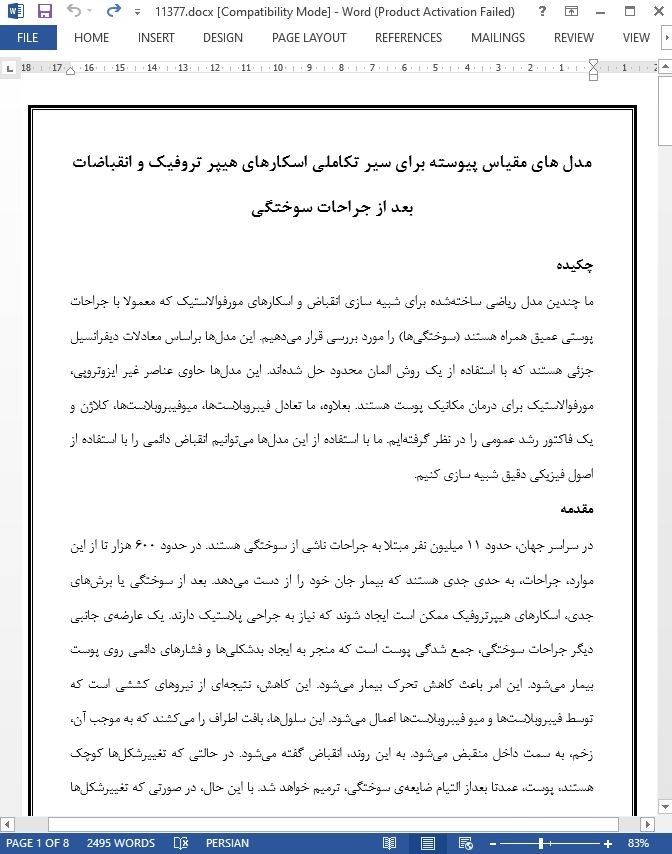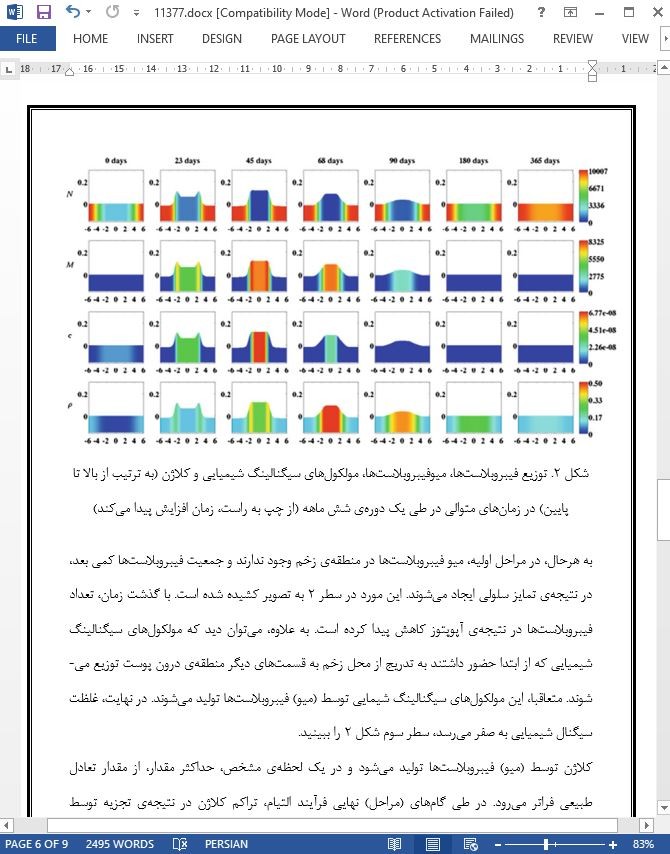
مدل های مقیاس پیوسته برای سیر تکاملی اسکارهای هیپر تروفیک و انقباضات بعد از جراحات سوختگی
چکیده
ما چندین مدل ریاضی ساخته شده برای شبیه سازی انقباض و اسکارهای مورفوالاستیک که معمولا با جراحات پوستی عمیق همراه هستند (سوختگی ها) را مورد بررسی قرار می دهیم. این مدل ها براساس معادلات دیفرانسیل جزئی هستند که با استفاده از یک روش المان محدود حل شده اند. این مدل ها حاوی عناصر غیر ایزوتروپی، مورفوالاستیک برای درمان مکانیک پوست هستند. بعلاوه، ما تعادل فیبروبلاست ها، میوفیبروبلاست-ها، کلاژن و یک فاکتور رشد عمومی را در نظر گرفته ایم. ما با استفاده از این مدل ها می توانیم انقباض دائمی را با استفاده از اصول فیزیکی دقیق شبیه سازی کنیم.
مقدمه
در سراسر جهان، حدود 11 میلیون نفر مبتلا به جراحات ناشی از سوختگی هستند. در حدود 600 هزار تا از این موارد، جراحات، به حدی جدی هستند که بیمار جان خود را از دست می دهد. بعد از سوختگی یا برش-های جدی، اسکارهای هیپرتروفیک ممکن است ایجاد شوند که نیاز به جراحی پلاستیک دارند. یک عارضه ی جانبی دیگر جراحات سوختگی، جمع شدگی پوست است که منجر به ایجاد بدشکلی ها و فشارهای دائمی روی پوست بیمار می شود. این امر باعث کاهش تحرک بیمار می شود. این کاهش، نتیجه ای از نیروهای کششی است که توسط فیبروبلاست ها و میو فیبروبلاست ها اعمال می شود.
بحث
مدل هایی که در این نسخه ی خطی نشان داده ایم، همگی بر اساس تراکم های سلولی هستند و از خصوصیات کاملا مقیاس پیوسته برخوردارند. برای در نظر گرفتن فرآیندها در مقیاس بسیار کوچک، می توان مدل های خیلی کوچک مانند فرمولاسیون های پاتز سلولی یا مدل های مبتنی بر سلول نیمه پیوسته را در نظر گرفت. به هرحال، برای مقیاس های بزرگتر، استفاده از مدل های مقیاس پیوسته ی مبتنی بر معادلات دیفرانسیل جزئی فعلی مناسب است زیرا مدل های مبتنی بر سلول، نیاز به منابع محاسباتی بیش از حدی دارند. تحقیقات مورد نظر می تواند در جهت افزایش مقیاس مدل های کوچک مقیاس به سمت مقیاس های بزرگتر هدایت شود. مدل-های فعلی، ارتباط با سیستم ایمنی را از دست می دهند. این ارتباط می تواند در آزمایش های بالینی بیشتر مورد بررسی قرار بگیرند تا مدل هایی که انقباض زخم و هیپرتروفی را با هم جفت می کنند، بتواند فرموله (تهیه) شود.
Abstract
We review several of our mathematical models that we constructed for the simulation of contractures and morpho-elastic scars that are typically associated with deep dermal (burn) injuries. The models are based on partial differential equations, which are solved by the use of finite-element methods. The models contain elements of non-isotropy, morpho-elasticity for the treatment of the mechanics of the skin. Furthermore, we take into account the balances of fibroblasts, myofibroblasts, collagen and a generic growth factor. Using the models, we are able to simulate permanent contractions using physically sound principles.
Introduction
Over the globe, about eleven million individuals are affected by burn injuries. In about six hundred thousand cases, the injury is so serious that the patient dies. After serious burns or incisions, hypertrophic scars may arise among patients, who need plastic surgery. Another side effect of burn injuries is the formation of contractures, which lead to permanent deformations and stresses in the skin of the patient. This causes a reduction of the mobility of the patient. This reduction is a consequence of the pulling forces that are exerted by the fibroblasts and myo-fibroblasts.
Discussion
The models that we have shown in this manuscript are all based on cell densities and they have a fully continuum-scale character. In order to consider the processes on a very small scale, it could be worth to consider small-scale models like the cellular Potts formulations or semi-continuous cell-based models. However, for larger scales, it is appropriate to use the current partial differential equations-based continuum-scale models since cell-based models would require too many computational resources. Research of interest could be directed to the upscaling of small-scale models to larger scales. The current models further miss the link to the immune system. This link could be investigated more in clinical experiments so that models that couple wound contraction and hypertrophy can be formulated.
چکیده
مقدمه
مواد و روش ها
نتایج
بحث
Abstract
Introduction
Materials and Methods
Results
Discussion
- اصل مقاله انگلیسی با فرمت ورد (word) با قابلیت ویرایش
- ترجمه فارسی مقاله با فرمت ورد (word) با قابلیت ویرایش، بدون آرم سایت ای ترجمه
- ترجمه فارسی مقاله با فرمت pdf، بدون آرم سایت ای ترجمه


